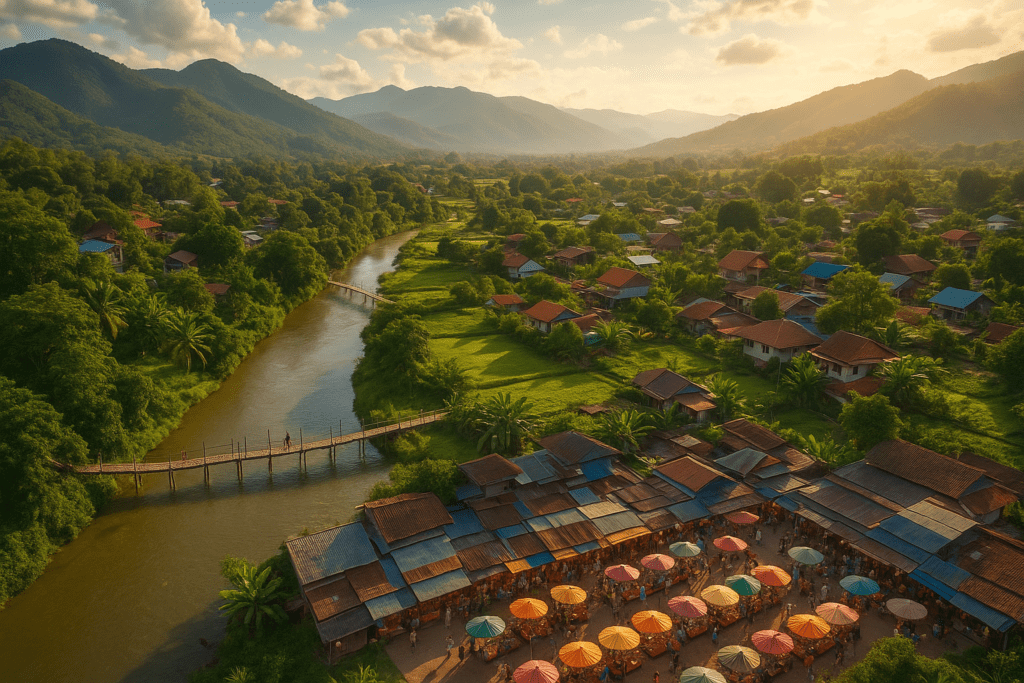🎯 Key Takeaways
- Budget as low as $15 USD per day for ultra-frugal travelers in Pai
- Mid-range comfort available for around $50 USD daily
- Minimum 3-4 days recommended to experience Pai’s magic
- Riverside areas offer the best value for cheap accommodation
- Scooter rental provides freedom to explore affordable natural attractions
- Pai Night Market is essential for budget-friendly dining
- Many top attractions like Pai Canyon and waterfalls have free or minimal entry fees
📋 Table of Contents
- Introduction: Welcome to Pai – Thailand’s Budget-Friendly Mountain Gem
- Estimating Your Total Trip Cost: “How much money do you need for Pai?”
- Affordable Accommodation in Pai: Finding Your Budget-Friendly Base
- Getting To and Around Pai on a Shoestring
- Eating Well in Pai Without Overspending: A Foodie’s Budget Guide
- Affordable Things to Do in Pai: Maximizing Fun, Minimizing Cost
- Sample Daily Budget Itineraries: Visualizing Your “Backpacking Pai Cost”
- Money-Saving Tips & Hacks for Your “Pai on a budget” Adventure
- Planning Checklist & Essential Resources: Your “Pai travel budget guide” Toolkit
- Conclusion: Your Unforgettable Adventure in Pai on a Budget Awaits!

Planning a trip to Pai on a budget doesn’t mean sacrificing the magic of this mountain paradise. This comprehensive guide will show you exactly how to experience Thailand’s beloved hippie haven without breaking the bank, proving that incredible adventures are accessible to every traveler.
Introduction: Welcome to Pai – Thailand’s Budget-Friendly Mountain Gem
Pai on a budget is not just possible—it’s one of the best ways to experience this enchanting destination. Nestled in the mountains of northern Thailand, this laid-back town has become a magnet for budget-conscious travelers seeking authentic experiences without the hefty price tag.
Why Pai for Budget Travelers?
Pai has solidified its reputation as a premier choice for budget-conscious travelers in Northern Thailand thanks to its unique blend of stunning natural beauty, famously laid-back hippie atmosphere, and overall affordability. The town offers everything from misty mountains and cascading waterfalls to dramatic canyons, all wrapped in an atmosphere that encourages travelers to slow down and savor the moment. Learn more about Pai’s attractions on Skye Travels.
Daily expenses can be impressively low, with backpacking Pai cost potentially dropping to just $15 (approximately 500 THB) for those on a super tight budget who embrace dorm-style accommodations and local street food.
Pai’s Enduring Appeal
This mountain town isn’t a new discovery; it has been a beloved staple on the Thailand backpacker trail for decades. Despite its growing popularity over the years, Pai has successfully maintained its inherent charm and, crucially, its affordability compared to more expensive tourist hotspots throughout Thailand. Discover Pai’s enduring appeal at Mini Adventures.
This combination makes it especially attractive for travelers looking to maximize their travel funds without compromising on unforgettable experiences.
What This Pai Travel Budget Guide Covers
This comprehensive Pai travel budget guide will delve into everything you need to plan your dream trip to Pai on a budget, including:
- Realistic cost estimates answering “how much money do you need for Pai“
- Finding the best cheap accommodation Pai and top budget hostels Pai
- Navigating transportation to and around Pai affordably
- Eating incredible food without overspending
- Discovering countless affordable things to do Pai
- Sample daily itineraries with detailed backpacking Pai cost breakdowns
Estimating Your Total Trip Cost: “How much money do you need for Pai?”

The burning question every budget traveler asks: “how much money do you need for Pai?” The answer depends on your travel style, but Pai’s affordability makes it accessible to virtually every budget level.
Daily Budget Breakdown for Pai
Low-end Budget: $15 USD per day
This ultra-frugal option covers approximately 500-550 THB daily and typically includes:
- A bed in a basic dormitory room
- Simple, local meals from street food stalls or self-prepared food
- Minimal paid activities, focusing primarily on free natural attractions and temple visits
Mid-range Budget: $50 USD per day
This comfortable option allows approximately 1,700-1,800 THB daily for:
- Nicer cheap accommodation Pai such as private rooms in guesthouses or upgraded hostels
- Dining at a mix of local eateries and Pai’s unique cafes and restaurants (excluding significant alcohol expenses)
- Engaging in premium activities, tours, and entrance fees for developed attractions
Perspective on Spending
Anything significantly beyond $50 USD per day would likely be considered leaning towards luxury for Pai’s general offerings and cost of living, though higher-end options certainly exist for those seeking them.
Sample Trip Budgets
The minimum recommended stay to truly experience Pai’s magic is 3 full days and 4 nights. This allows enough time to explore the town, visit key natural attractions, and soak in the relaxed atmosphere without feeling rushed.
3-day trip budgets:
- Low-end: $45 USD total ($15 × 3 days)
- Mid-range: $150 USD total ($50 × 3 days)
Many travelers fall in love with Pai’s charm and extend their stays to 5-7 days or even longer once they arrive.
5-day trip budgets:
- Low-end: $75 USD total
- Mid-range: $250 USD total
7-day trip budgets:
- Low-end: $105 USD total
- Mid-range: $350 USD total
Tips on Currency Exchange and Emergency Funds
Currency and Exchange
Thailand uses Thai Baht (THB). Consider exchanging some money in major cities like Chiang Mai for potentially better rates, though ATMs are readily available in Pai. Be aware of typical withdrawal fees from both Thai banks and your home bank. Some exchange booths operate in Pai town for convenience.
Carrying Money
Maintain a mix of cash for daily expenses like street food and small purchases, plus cards for larger payments and ATM withdrawals. Many small vendors and rural attractions only accept cash.
Emergency Funds
Always maintain access to emergency funds through a separate bank account or credit card reserved specifically for unexpected situations. This provides peace of mind without affecting your daily Pai travel budget guide calculations.
Affordable Accommodation in Pai: Finding Your Budget-Friendly Base
Securing cheap accommodation Pai is easier than you might expect, with numerous options catering specifically to budget travelers and backpackers.
Overview of Budget Accommodation Options
Pai offers a wealth of affordable places to stay conveniently located on both sides of the Pai River. The Riverside area stands out as particularly budget-friendly, where travelers often find lower rates for bungalows and guesthouses while remaining within easy walking or cycling distance to downtown amenities and the famous Pai Walking Street. Find accommodation tips at The Broke Backpacker.
Types of Cheap Accommodation Pai
Budget Hostels Pai
These social hubs offer dormitory beds (typically 4-12 beds, either mixed or gender-specific) and sometimes private rooms at higher rates.
Pros: Very affordable (dorm beds often $5-10 USD), excellent for meeting fellow travelers, common areas and kitchens, tour booking services, reliable Wi-Fi
Cons: Can be noisy, limited privacy in shared dorms
Location: Plentiful in downtown Pai and along the riverside areas
Guesthouses
Often family-run establishments offering private rooms with either shared or private bathrooms at reasonable prices.
Pros: More privacy than hostel dorms, authentic local experience, often excellent value
Cons: Fewer opportunities for social interaction compared to hostels
Typical rates: $10-25 USD for basic but clean private rooms
Budget Bungalows
Simple, often rustic individual or semi-detached huts common in riverside areas or slightly outside town.
Pros: Complete privacy, escape-like atmosphere, can be very economical
Cons: Facilities might be basic (fan-only cooling, cold showers)
Booking Advice for Cheap Accommodation Pai
Book Well in Advance
Strongly consider booking accommodation well ahead of your arrival, especially during high season (November through March). Popular budget hostels Pai and guesthouses fill up quickly during peak periods, and last-minute options may be limited or more expensive.
Flexibility vs. Security
While many travelers find themselves wanting to extend their Pai stay beyond original plans, securing your initial nights during peak times provides important peace of mind and prevents accommodation stress upon arrival.
Getting To and Around Pai on a Shoestring
Mastering cost-effective transportation is crucial for any successful Pai on a budget adventure.
Transport to Pai (from Chiang Mai)
Pai’s airport has been discontinued for commercial flights, making Chiang Mai the primary gateway for budget travelers.
Budget Transportation Options:
Local Bus
The most economical choice departing from Chiang Mai’s Arcade Bus Station (Terminal 2). Journey time runs 3-4 hours with multiple stops, costing approximately 150-200 THB. This option provides an authentic local travel experience.
Shared Minivan
The more popular and slightly faster option taking around 3 hours including rest stops. Famous for its 762 curves, so motion sickness medication is recommended for susceptible travelers. Cost ranges from 200-300 THB and can be booked through guesthouses, Chiang Mai travel agents, or online platforms.
Important Booking Advice
Reserve transportation to and from Pai well in advance, especially during high season (November-March), as seats frequently sell out during popular travel periods.
Local Transportation in Pai
Motorbike/Scooter Rental
This represents the most popular and relatively affordable method for exploring Pai and surrounding attractions, providing complete freedom and flexibility.
Daily rental prices: 100-250 THB for automatic scooters, depending on model and rental duration
Fuel costs: Very economical; a full tank (around 100 THB) lasts several days of moderate exploration
Important Safety Note: Pai’s mountain roads can be winding and challenging for inexperienced riders. Always wear helmets and protective clothing. For more detailed safety advice, see Top 10 Tips for Staying Safe While Riding a Motorbike in Thailand.
Need guidance on selecting the best bike for your trip? Check out The Best Motorcycles to Hire for Beginners in Thailand.
For a hassle-free start to your scenic rides, consider checking scooter rental options on Byklo before arrival to compare prices and secure reliable transportation for your Pai adventures.
Alternative Local Transport
Bicycle Rentals: Even more economical and eco-friendly for exploring areas closer to town or for those uncomfortable with scooters. Daily rentals typically cost 50-100 THB.
Walking: Downtown Pai, including the main walking street and many guesthouses and restaurants, is compact and entirely walkable.
Taxi/Motorbike Taxi: Available for shorter trips or transport to/from the bus station, but costs accumulate with frequent use. Always agree on fares beforehand since meters are uncommon.
Eating Well in Pai Without Overspending: A Foodie’s Budget Guide

Pai’s diverse food scene caters perfectly to travelers pursuing Pai on a budget without sacrificing culinary adventures.
The Star of Budget Eating: Pai Night Market (Pai Walking Street)
The Pai Night Market stands as an absolute must-visit for anyone on a Pai on a budget trip. This vibrant marketplace comes alive every evening, offering an incredible array of affordable and delicious local and international street food options. Explore Pai’s night market at Mini Adventures.
Expect to find Pad Thai, Khao Soi, BBQ skewers (pork, chicken, mushroom varieties), fresh fruit smoothies, roti pancakes, grilled corn, spring rolls, sushi, and unique local snacks. Individual dishes typically range from 20-60 THB, allowing for a complete, varied meal under 100-150 THB.
Local Eateries vs. Tourist-Focused Restaurants
Seek out small, local Thai eateries often located on side streets or away from the main tourist areas. These establishments usually offer authentic dishes at significantly lower prices compared to restaurants clearly targeting Western tourists, which often feature higher prices and sometimes less authentic cuisine.
Look for establishments busy with locals—this consistently indicates both quality food and excellent value for money.
Budget-Friendly Cafés
Pai has developed a renowned café culture over the years. While some establishments cater to higher budgets, many offer affordable coffee, tea, and light meals or baked goods. The famous Strawberry Cafe serves as an example of Pai’s unique themed café scene, perfect for a drink or photo opportunity even on tight budgets.
Self-Catering Tips
If staying in budget hostels Pai or guesthouses with kitchen facilities, consider purchasing fresh fruit, vegetables, bread, and other staples from local morning markets or small supermarkets. This strategy provides excellent savings on breakfast and lunch costs while allowing you to sample local ingredients.
Affordable Things to Do in Pai: Maximizing Fun, Minimizing Cost

Pai overflows with affordable things to do Pai and completely free activities that showcase the region’s natural beauty and cultural richness.
Free or Low-Cost Natural Attractions
Pam Bok Waterfall: Easily accessible with small entry fees (20-40 THB). Perfect for refreshing swims and photography.
Mo Paeng Waterfall: Popular with both locals and tourists, featuring natural rock slides for adventurous visitors. Usually free entry or minimal fees.
Pai Canyon (Kong Lan)
A must-see destination, especially for sunset viewing. Free entry provides access to narrow ridges and impressive valley views. Wear appropriate footwear for safety on the rocky terrain.
Hot Springs
Sai Ngam Hot Springs (Secret Hot Springs): More natural and less developed with cheaper entry fees (20-40 THB per person plus 20 THB for scooter parking). A genuine local favorite.
Tha Pai Hot Springs: More developed park-like setting with various temperature pools and better facilities. Higher entrance fee (300 THB for foreigners) but excellent amenities.
Free or Low-Cost Cultural, Scenic & Quirky Spots
Bamboo Bridge (Boon Ko Ku So)
This picturesque, lengthy bamboo bridge stretches across scenic rice paddies leading to a traditional temple. Small donations or entry fees support local maintenance efforts.
Wat Phra That Mae Yen (White Buddha on the Hill)
Climb the temple stairs for panoramic views of the entire Pai valley. Free to visit (donations welcomed), with spectacular sunset viewing opportunities.
Yun Lai Viewpoint
Offers stunning sunrise views over seas of mist when weather conditions cooperate. Small entry fees (around 20 THB) often include complimentary Chinese tea service.
Santichon Village (Chinese Clay House Village)
A fascinating Yunnanese cultural village featuring traditional clay houses, tea tasting experiences, and unique photo opportunities. Free to explore with small fees for specific activities.
Land Split
An unusual geological site where earthquake activity split a farmer’s land. The friendly owner offers roselle juice and local snacks for modest donations.
Sample Activities: DIY Adventure Ideas
Scooter Adventure Loops
Plan self-guided scooter routes hitting multiple attractions in single days. Exploring these affordable things to do Pai like the Bamboo Bridge, various waterfalls, and remote viewpoints becomes most rewarding with transportation freedom. For reliable and competitively priced scooter rentals, Byklo offers helpful pre-planning resources for self-guided adventures. For additional two-wheeled travel inspiration, see Exploring Thailand on Two Wheels – Your Guide to Motorcycle Adventures.
Sample Day Ideas
Day 1: Morning visit to Pam Bok Waterfall and Bamboo Bridge. Afternoon stop at Strawberry Cafe for photos and refreshments, then Pai Canyon for sunset viewing. Evening exploration of Pai Night Market.
Day 2: Early morning at Yun Lai Viewpoint for sunrise, followed by Santichon Village exploration. Afternoon relaxation at Sai Ngam Hot Springs, ending with sunset viewing from elevated spots. Evening dining and entertainment in town. Plan your itinerary with Mini Adventures.
Sample Daily Budget Itineraries: Visualizing Your “Backpacking Pai Cost”
Understanding backpacking Pai cost becomes clearer through practical daily examples showing how budget principles work in real-world scenarios.
Assumptions
These examples assume travelers stay in budget hostels Pai or cheap guesthouses, rent scooters (potentially sharing costs), and eat a combination of street food and local eatery meals.
Backpacking Pai Cost Sample: Day 1 – Arrival & Town Exploration
Morning/Afternoon: Arrive and check into hostel or guesthouse accommodation ($5-10 USD)
Lunch: Local street food or simple restaurant meal ($2-3 USD)
Afternoon: Walking exploration of Pai town, visit Wat Klang temple, cross bamboo bridges over Pai River in town center
Evening: Explore Pai Night Market with dinner from various stalls ($3-5 USD)
Total Estimated Daily Cost: $10-18 USD
Backpacking Pai Cost Sample: Day 2 – Nature & Viewpoints Loop
Breakfast: Hostel-provided or fresh fruit from local market ($1-2 USD)
Morning: Scooter rental ($3-5 USD daily, less if shared or longer rental). Visit free Pai Canyon, then Mo Paeng Waterfall (free or small fee)
Lunch: Local eatery near attractions or back in town ($2-4 USD)
Afternoon: Wat Phra That Mae Yen (White Buddha) for panoramic views (free entry)
Evening: Sunset viewing from White Buddha or nearby viewpoints. Dinner at Night Market or local establishment ($3-5 USD)
Total Estimated Daily Cost: $9-21 USD (plus shared scooter rental costs)
Backpacking Pai Cost Sample: Day 3 – Culture & Relaxation
Breakfast ($1-2 USD)
Morning: Santichon Village exploration (free entry), then Yun Lai Viewpoint (small fee around $1 USD)
Lunch: At Santichon Village or return to Pai ($2-4 USD)
Afternoon: Relaxation at Sai Ngam Hot Springs (entry fee $1-2 USD plus scooter parking)
Evening: Final Night Market exploration or slightly nicer local restaurant meal ($3-6 USD)
Total Estimated Daily Cost: $8-20 USD (plus shared scooter rental and hot spring entry)
Daily Budget Breakdown Recap (Low-End)
- Accommodation: $5-10 for dormitory beds, especially in Riverside areas where cheap accommodation Pai options abound
- Food: $3-8 for modest meals at local eateries and street food vendors
- Transportation: $3-5 daily motorbike rental (less when shared or bicycle alternatives)
- Activities: Many attractions free or minimal entrance fees
- Miscellaneous: $2-3 for water (use refill stations!) and small expenses
Variations for Different Budget Levels
Ultra-Budget Approach
Stick to absolute cheapest dormitories, exclusively street food or self-catering, walk more or use bicycle rentals, focus only on free attractions like Pai Canyon, some waterfalls, and temple visits. Possible under $15 daily.
Comfort-Budget Approach
Private guesthouse rooms ($15-25), mix of street food and nicer cafés ($10-15), reliable scooter rental, more paid attractions or half-day tours ($10-15). Approximately $35-50 daily.
Money-Saving Tips & Hacks for Your “Pai on a budget” Adventure
These practical strategies help stretch every dollar while experiencing Pai on a budget to its fullest potential.
Accommodation Savings
Travel Off-Peak Seasons
Consider visiting just before or after main high season (November-March) for potentially lower accommodation prices and fewer crowds. October and April-May might offer savings despite warmer or wetter weather conditions.
Book Longer Stays
Many budget hostels Pai and guesthouses offer weekly or monthly rates providing significant savings for extended visits. Always inquire about long-term discounts.
Strategic Location Choices
Riverside accommodations and those slightly outside town centers often offer better rates while maintaining accessibility to main attractions and amenities.
Food and Drink Savings
Eat Like Locals
Prioritize street food from Night Markets and meals at small, family-operated Thai eateries for authentic experiences at local prices.
Happy Hour Opportunities
Many bars offer happy hour specials with 2-for-1 deals or discounted drinks for budget-conscious evening entertainment.
Water Refill Strategy
Many guesthouses, cafés, and public locations offer water refill stations for minimal fees, saving money while reducing plastic waste.
7-Eleven Basics
For ultra-budget options, 7-Eleven stores stock cheap toasties, yogurt, fresh fruit, and coffee for quick, affordable meals.
Transport and Activity Savings
Maximize Walking
Pai town’s compact size makes walking feasible for many daily activities and short-distance transportation.
Share Transportation Costs
Traveling with friends allows sharing scooter rental and fuel expenses, significantly reducing individual transportation costs.
Prioritize Free Activities
Abundant options include Pai Canyon, many waterfalls, temple visits, and walking street exploration without entrance fees.
Maximizing your Pai on a budget trip often means smart transportation choices. Renting scooters provides access to numerous affordable things to do Pai independently. Using comparison services like Byklo helps secure the best rental rates from trusted local vendors through pre-booking advantages.
Planning Checklist & Essential Resources: Your “Pai travel budget guide” Toolkit
Proper preparation ensures smooth execution of your Pai travel budget guide strategy while avoiding common budget-busting mistakes.
Critical Reservations (High Season Priority)
Accommodation Booking
Reserve your cheap accommodation Pai or budget hostels Pai well in advance, particularly for November through March travel periods when demand peaks significantly.
Transportation Tickets
Secure bus or minivan tickets from Chiang Mai ahead of time, especially during busy seasons when seats sell out quickly.
Essential Packing List for Pai on a Budget
Climate-Appropriate Clothing
Pack lightweight, breathable clothing for warm daytime weather, but remember that Pai’s mountain location creates considerably cooler conditions than other Thai destinations, especially during evening hours and November through March high season months.
Essential items include:
- Long-sleeved shirts and pants (crucial for cool mountain evenings and motorbike protection)
- Light jacket or fleece for cooler mornings and evenings
- Rain gear (poncho or light waterproof jacket) for rainy season travel (May-October)
- Swimwear for waterfalls and hot springs
- Comfortable walking shoes and sandals
- Sun protection: sunscreen, sunglasses, hat
- Insect repellent
- Reusable water bottle
- Basic first-aid supplies
- Travel adapter and power bank
Money & Documentation Essentials
- Passport and visa documentation (if required)
- Copies of important documents
- Travel insurance information
- ATM and credit cards (notify banks of travel plans)
- Thai Baht cash reserves
Recommended Apps & Digital Resources
- Accommodation: Hostelworld, Booking.com, Agoda
- Navigation: Google Maps (download offline), Maps.me
- Utilities: XE Currency converter, Google Translate (Thai)
- Transportation: 12go.asia for Southeast Asian bus/minivan booking
Weather Considerations Summary
Pai’s mountain elevation creates generally cooler conditions than southern Thailand. High season (November-March) brings pleasant daytime temperatures but cool evenings requiring warm clothing. Hot season (March-May) can be intensely warm, while rainy season (May-October) creates lush landscapes alongside potential heavy downpours.
Conclusion: Your Unforgettable Adventure in Pai on a Budget Awaits!
Experiencing Pai on a budget is not only entirely achievable but incredibly rewarding for travelers seeking authentic mountain paradise adventures without financial stress.
This comprehensive Pai travel budget guide demonstrates that Pai offers exceptional value for budget-conscious travelers. Daily expenses can realistically start as low as $15 for those embracing basic accommodations and local food culture, or around $50 daily for more comfortable mid-range experiences that remain very affordable by international standards.
The recommended minimum duration of at least 3 full days (4 nights) allows proper appreciation of Pai’s unique atmosphere, though many travelers find themselves extending stays once they experience the town’s magnetic charm and laid-back culture. The combination of stunning natural beauty, welcoming local community, and budget-friendly options creates an irresistible destination for travelers seeking to maximize their Thailand experience without overspending.
Whether you’re drawn to misty mountain viewpoints, cascading waterfalls, vibrant night markets, or simply the legendary traveler atmosphere, this Pai travel budget guide provides all the tools and insider knowledge needed to create unforgettable memories while maintaining financial responsibility.
Are you ready to explore Pai on a budget? Have you visited Pai and discovered your own money-saving tips or favorite affordable spots? Share your experiences and insights in the comments below—we’d love to hear about your budget travel adventures in Thailand’s mountain paradise!
For an effortless scooter rental experience, rent your motorbike from Byklo.rent and get ready to hit Pai’s scenic roads!
❓ Frequently Asked Questions
How much does it cost to visit Pai for 3 days?
A 3-day trip to Pai can cost as little as $45 USD total for ultra-budget travelers staying in dorms and eating street food, or around $150 USD for mid-range comfort with private rooms and varied dining options. Most travelers find $75-100 USD provides a good balance of comfort and affordability for 3 days.
Is Pai expensive for backpackers?
No, Pai is very affordable for backpackers. Daily costs can be as low as $15 USD including accommodation, food, and activities. Dorm beds cost $5-10 USD, street food meals are $2-5 USD, and many top attractions like Pai Canyon and waterfalls are free or have minimal entry fees.
What’s the cheapest way to get from Chiang Mai to Pai?
The cheapest option is the local bus from Chiang Mai’s Arcade Bus Station, costing 150-200 THB ($4-6 USD) for a 3-4 hour journey. Shared minivans cost slightly more at 200-300 THB but are faster and more popular among travelers.
Where should I stay in Pai on a budget?
The Riverside area offers the best value for budget accommodation, with numerous hostels, guesthouses, and budget bungalows within walking distance of downtown. Dorm beds start around $5 USD, while private rooms in guesthouses range from $10-25 USD.
Do I need to book accommodation in advance in Pai?
Yes, especially during high season (November-March). Popular budget hostels and guesthouses fill up quickly during peak periods. Booking ahead ensures availability and often better rates, though you can sometimes find last-minute options during low season.
What are the must-see free attractions in Pai?
Top free attractions include Pai Canyon for sunset views, Wat Phra That Mae Yen (White Buddha) for panoramic valley views, several waterfalls like Mo Paeng, and the town’s bamboo bridges. Walking through downtown Pai and the night market is also completely free.
Is it safe to ride a scooter in Pai?
Pai’s mountain roads can be challenging with winding curves and elevation changes. Always wear a helmet, drive slowly, and avoid riding at night or in bad weather. If you’re inexperienced, consider practicing in town first or using alternative transportation like bicycles for shorter distances.
How much does food cost in Pai?
Street food at the night market costs 20-60 THB ($0.50-2 USD) per dish. A complete meal can be under 100 THB ($3 USD). Local eateries offer full meals for 80-150 THB ($2-4 USD), while tourist-oriented restaurants cost more at 150-300 THB ($4-8 USD) per meal.


